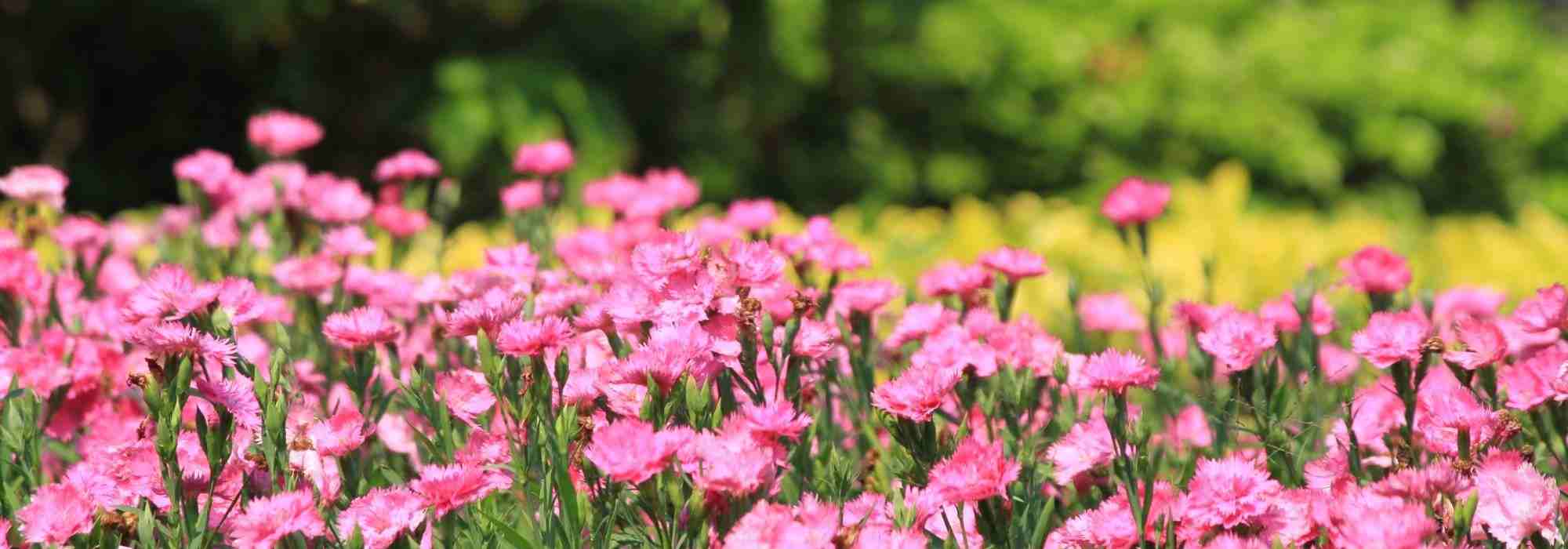
10 Dianthus to plant at the edge of a flower bed
Our favourite Dianthus!
Contents
ThePink is absolutely well-suited for planting in sunny border beds. It offers a wide array of flowers in different colours and shapes, diffusing a scent reminiscent of cloves. The ‘Scent First’ series features some beautiful original specimens. Blooming from spring to late summer, whether it is a carpet or bushy type, Dianthus easily colours our gardens alongside other perennial plants, thanks to its good floribundity and rapid growth. Here is our selection of 7 Pinks to install in the foreground of a border.
Dianthus plumarius ‘David’
In the category of red-flowered Pinks, we have the Dianthus plumarius ‘David’. This 1970 variety is appreciated for the intensity of its flower colour that enlivens gardens. Delightfully fragrant, the flowers are double and solid-coloured. The poppy red flowering occurs from June to September and creates a beautiful contrast with the rigid blue-green leaves. This spreading Pink is wider than it is tall: it grows up to 25 cm high and spreads about thirty centimetres. Once well established, it is quite drought-resistant. At the edge of a large sunny border, plant it alongside perennial plants with warm hues: Coreopsis, annuals like Marigolds, Cinquefoils, Helianthemums, or even Avens, such as the variety ‘Fire Storm’. The foliage of Japanese Forest Grass (Hakonechloa macra) adds a touch of green that perfectly complements the red of Dianthus ‘David’.

Dianthus plumarius ‘David’
Read also
Carnation: planting, care, sowing tipsDianthus deltoides ‘Rosea’
To add colour to a border, focus on the Dianthus deltoides ‘Rosea’. At maturity, this Heathland Pink forms a beautiful green carpet no taller than 15 cm, spreading harmoniously over about thirty centimetres. This tuft resembling lawn is well-suited for border planting, but also for carpeting sunny rockeries and walls. From May to August, this Dianthus produces small, solitary, simple flowers of 1 cm with five slightly fringed petals in a triangular shape. This is why it is also called Delta Pink. Upon closer inspection, you can notice the small details on each bright pink petal: the base is marked by a fine red edge, and small white spots are scattered throughout. Semi-evergreen, note that it remains decorative in winter. In the border of a bed, you can pair the spreading Pink ‘Rosea’ with alpine perennials, for example: the Alpine Gentian, the Stemless Silene, the Bellflower ‘Elizabeth Oliver’, or even the Dioecious Antennaria.

Dianthus deltoides ‘Rosea’
Discover other Dianthus - Pinks
View all →Available in 0 sizes
Available in 2 sizes
Available in 2 sizes
Available in 2 sizes
Available in 1 sizes
Available in 2 sizes
Available in 2 sizes
Available in 1 sizes
Available in 2 sizes
Available in 1 sizes
Dianthus plumarius ‘Scent First Sugar Plum’
Here is a Carnation producing stunning bicoloured flowers: the Dianthus plumarius ‘Scent First Sugar Plum’. From May onwards, it displays brown flower buds. Then, these open into double flowers, with dentate and undulate petals, tinged with a deep pink and speckled with rosy white. Rather compact, 25 cm in all directions, it can be grown in pots or as a border plant, effectively decorating with its rapid growth and good floribundity. Additionally, its fragrant flowers, about 4 cm in size, are present for a long time, from May to August. Combine the Carnation ‘Scent First Sugar Plum’ with blue flowering plants, such as Hardy Geraniums (for example ‘Ibericum’) or even Catmints. Pink and violet blue are two colours that easily complement each other.
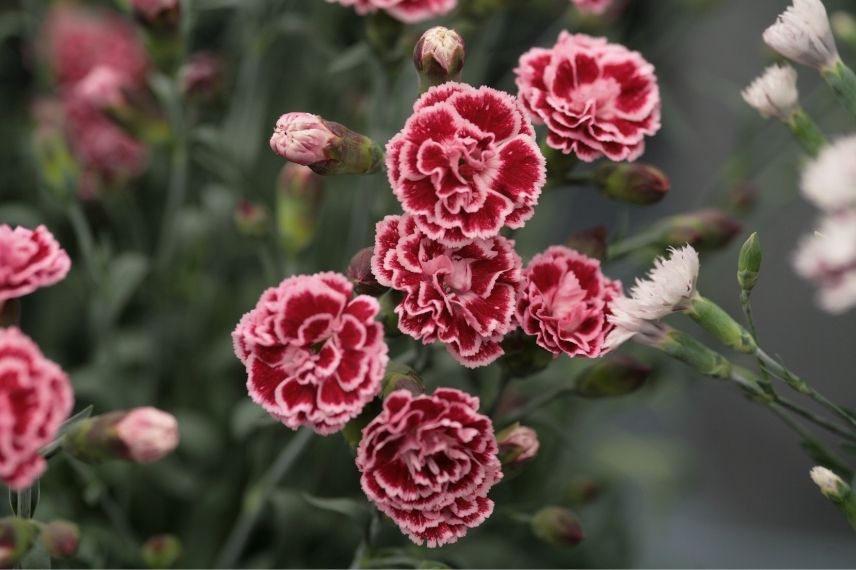
Dianthus plumarius ‘Scent First Sugar Plum’
Read also
Dianthus: 6 ideas to pair in the gardenDianthus plumarius ‘Devon Cream’
The Dianthus plumarius ‘Devon Cream’ stands out from other Pinks due to its unusual hues. When they bloom during summer, its flowers are adorned with a cream yellow, featuring some scattered very pale pink furrows. The combination of these two soft colours is delightful! Additionally, its solitary flowers are quite large and can measure 5 cm in diameter with a strong fragrance. They are equipped with numerous fringed petals. This cultivar is repeat flowering, meaning that after an initial bloom from May to July, a second flowering occurs in September. To encourage the appearance of new flowers, lightly prune the clump in August. With its rare and atypical beauty, pair the ‘Devon Cream’ Pink at the front of a border with Aubrieta ‘Cascade Blue’, Alchemilla vulgaris, and ‘Sweet Knirps’ Rose.
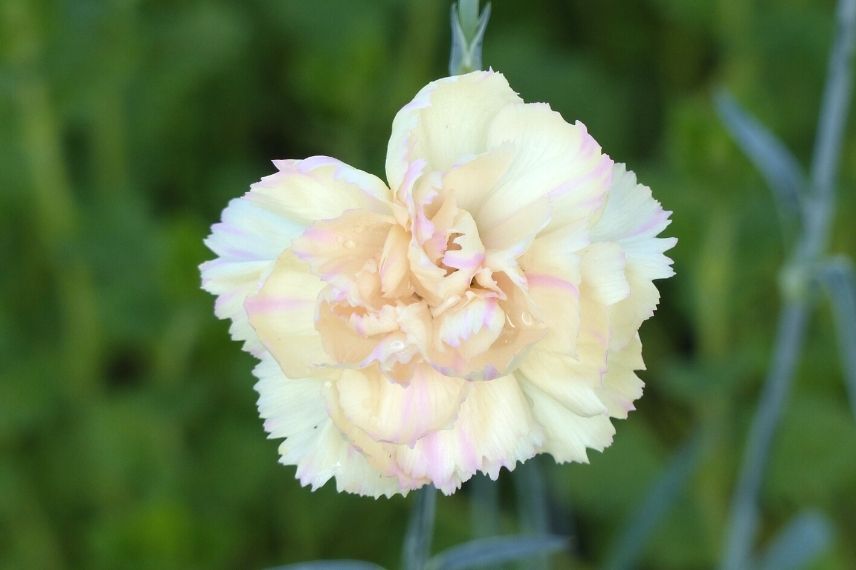
Dianthus plumarius ‘Devon Cream’
Dianthus plumarius ‘Devon Dove’
The Dianthus plumarius ‘Devon Dove’ is a recent cultivar. Very elegant, its flowering is truly worth seeing! From May to July, with a possible resurgence of flowers in September, this pinks blooms longer than older varieties. Its double flowers, with dentate edges, are like large cream-white pom-poms, about 5 cm in diameter. The firm, upright flower stems above the grey-green evergreen foliage can reach up to 40 cm in height. They are ideal as cut flowers for vase arrangements. In a bright border, pair the fragrant, spicy-sweet English pink ‘Devon Dove’ with the Basket of Gold with yellow flowers ‘Goldkugel’, Leucanthemum superbum ‘Becky’, and the Echinacea purpurea ‘Sunrise’ in the background.
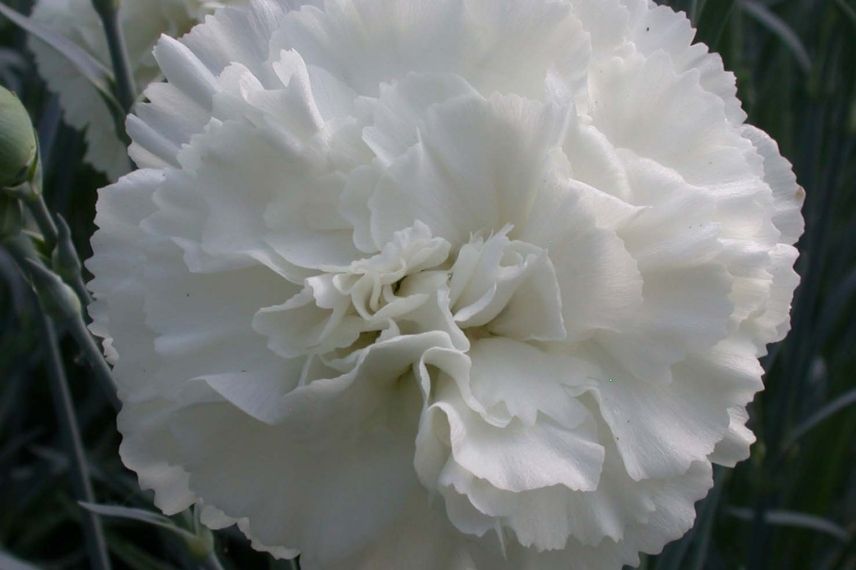
Dianthus plumarius ‘Devon Dove’
Dianthus superbus
The Dianthus superbus, also known as the Superb Pink or Fringed Pink, is valued for the lightness it brings with its summer flowering. Its large flowers (up to 5 cm in diameter), composed of five deeply laciniate petals and tinged with lilac pink, emit a pleasant fragrance that attracts pollinating insects. From June to September, a cloud of shaggy flowers covers the very fine, medium green foliage. This Dianthus also comes in red, Dianthus superbus ‘Crimsonia’, or bright pink, Dianthus superbus ‘Primadonna’. Place this original Pink preferably in cool soil, at the edges of a semi-shaded border, to allow the greatest number to enjoy it. Pair it with Scabious, the annual Cosmos ‘Sonata Rose’, the Campanula ‘Wedding Bells’, and the Plume Thistle ‘Atropurpureum’.

Dianthus superbus
Dianthus plumarius ‘Scent First Iced Gem’
The Dianthus plumarius ‘Scent First Iced Gem’ is part of the Scent First® series, which includes several particularly fragrant, compact, and floriferous Pinks. Delightful, this English cultivar grows into a dense cushion 30 cm high and wide, displaying evergreen, bluish-grey foliage. Its flowering is continuous from June to September: double flowers with slightly dentate edges, emitting a clove-like fragrance and coloured in a soft mauve pink with lighter edges. Just as charming and in the same pastel style, we can also mention the Dianthus plumarius ‘Scent First Romance’ with its salmon-pink flowers. Plant this Pink in a pale-toned border alongside Silene schafta ‘Splendens’, Spike Speedwell ‘Icicle’, and ‘First Love’, and finally, the Penstemon glaber.
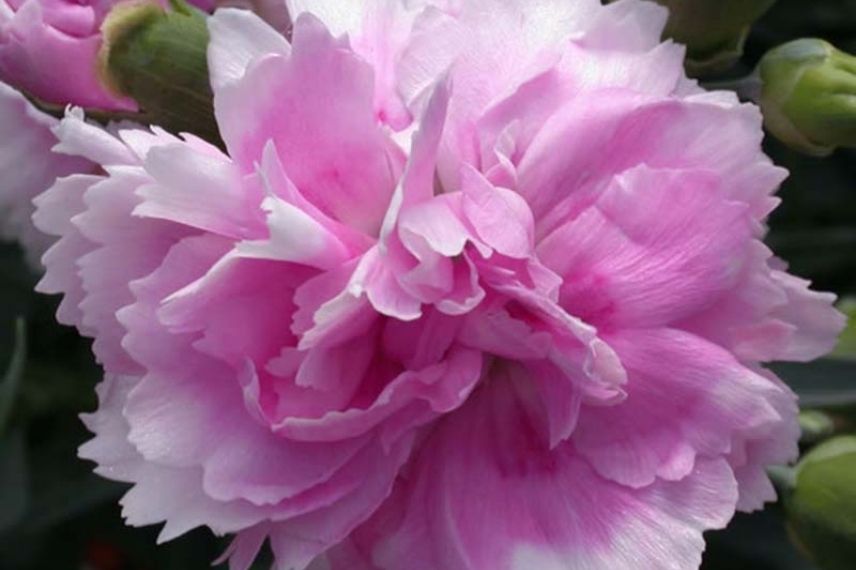
Dianthus plumarius ‘Scent First Iced Gem’
Dianthus plumarius ‘Scent First Raspberry Sundae’
The Dianthus plumarius ‘Scent First Raspberry Sundae’ is the pink version of the Dianthus plumarius ‘Scent First Coconut Sundae’. Indeed, the flowers of these two varieties are very similar: with a diameter of about 4 cm, featuring numerous fringed, bicoloured petals with a red centre. This one, however, is pastel pink. Rather late, it only develops its contrasting flowering from June onwards, continuing until August. When mature, its size is modest (25 cm in all directions). This compact cushion with short, sturdy flower stems can also be grown in pots or window boxes and withstands temperatures down to -15°C. The abundant flowering of this feathery pink will be highlighted in a sunny border, alongside sweet alyssum, variegated ‘Harlequin’ spindle, helianthemums, and Aster sibiricus.
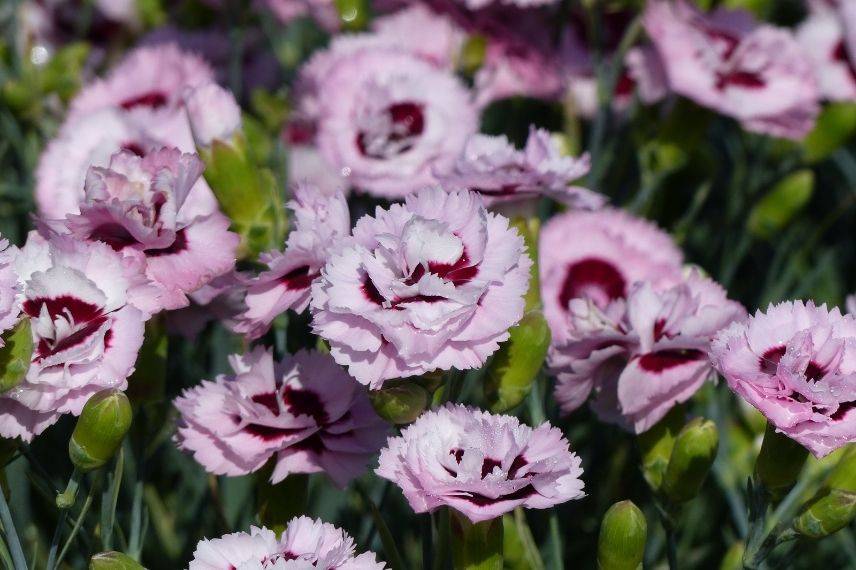
Dianthus plumarius ‘Scent First Raspberry Sundae’
Dianthus carthusianorum
The Dianthus carthusianorum stands out from other Pinks due to its thread-like appearance. Also known as the Chartreuse Pink, it produces long, slender floral stems from July to August. Well-erected, these can reach up to 40 cm above the foliage resembling a lawn. The flowers with 5 petals of a vibrant pink are small, single, and inserted in a black calyx. They are perfect for creating cut flower arrangements. This Dianthus spreads little in width, with the clump generally remaining tight (20 cm in diameter). For a successful prairie-inspired combination, plant it with Eryngium planum ‘Blue Hobbit’, Yarrow ‘Red Velvet’, Lychnis flos cuculi ‘Jenny’, and Roman Chamomile.

Dianthus carthusianorum (photo FarOutFlora)
Dianthus plumarius ‘Maggie’
The Dianthus plumarius ‘Maggie’ is a small-sized Carnation, rather spreading: 20 cm high and 30 cm wide. It therefore finds its place admirably in the border of a flowerbed or in a pot, offering us a generous and original summer flowering. Carried on short stems, its large, very double, frilled flowers, pink with a crimson heart, catch the eye. Very floriferous, this cultivar exudes a strong fragrance from June to August. Evergreen and with good hardiness (it withstands cold down to -15°C), this English Carnation can spend the winter outdoors while retaining its foliage. Easy to grow, plant the Dianthus ‘Maggie’ in full sun. Its low, persistent grey-green tuft pairs beautifully with the grey foliage of Stachys byzantina or Veronica ‘Silbersee’, with Sage ‘Blue Marvel’, hardy geraniums, and Phlox.

Dianthus plumarius ‘Maggie’
- Subscribe!
- Contents
































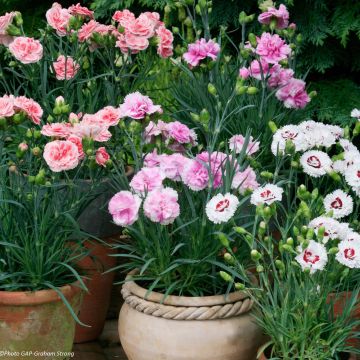
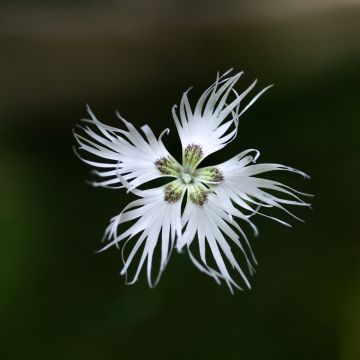



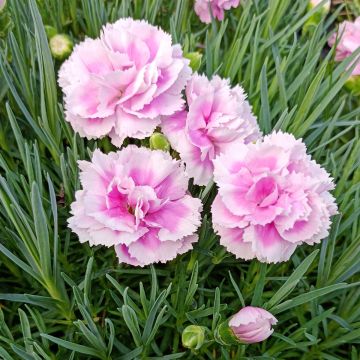

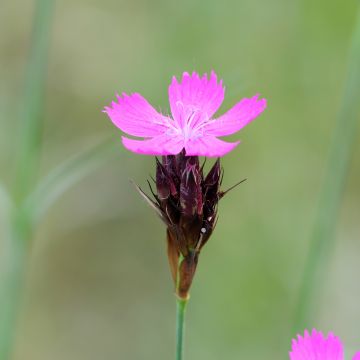
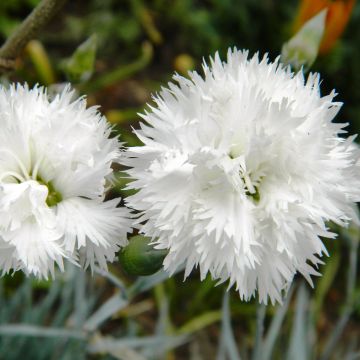

Comments